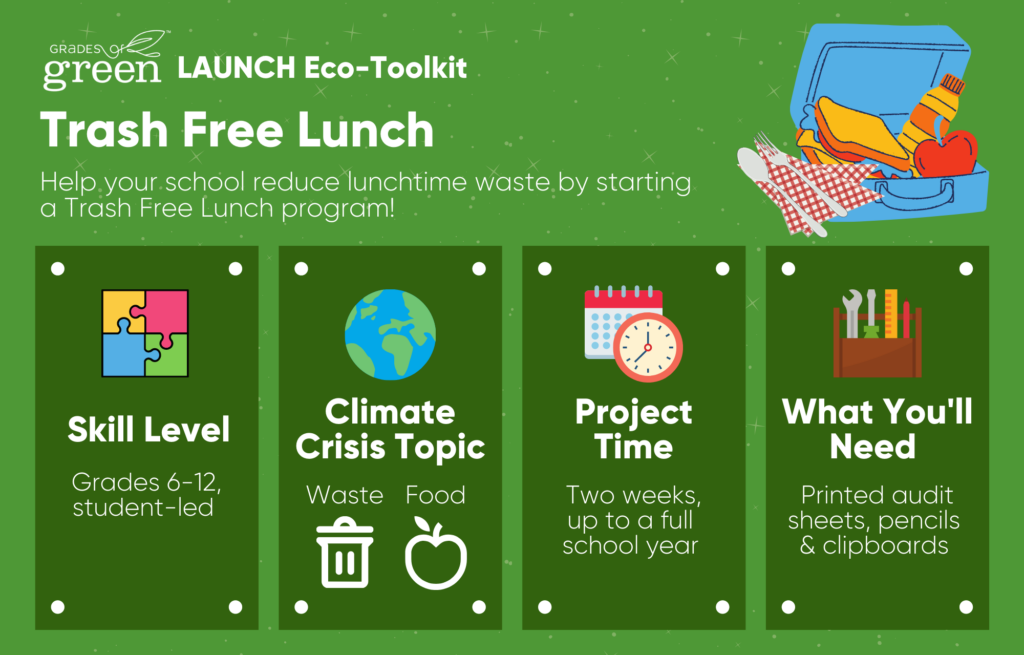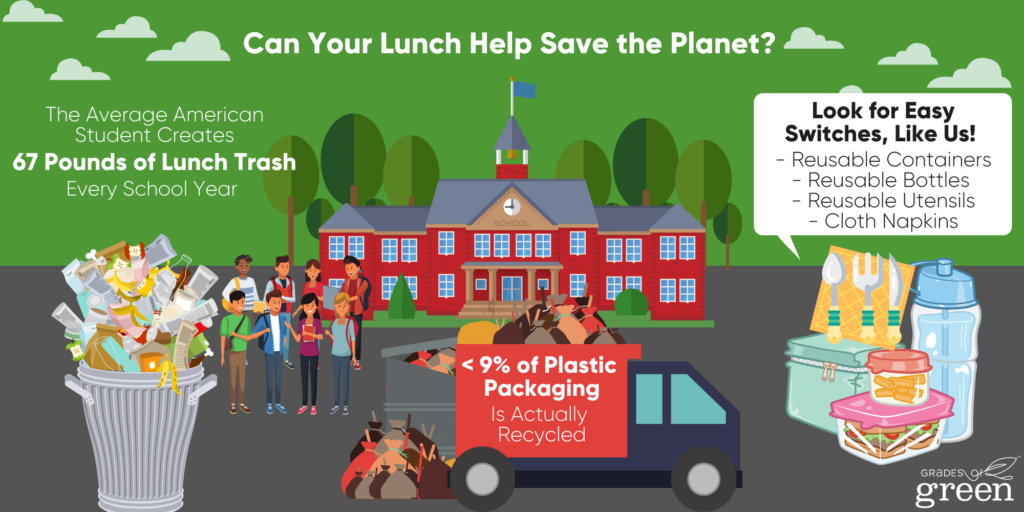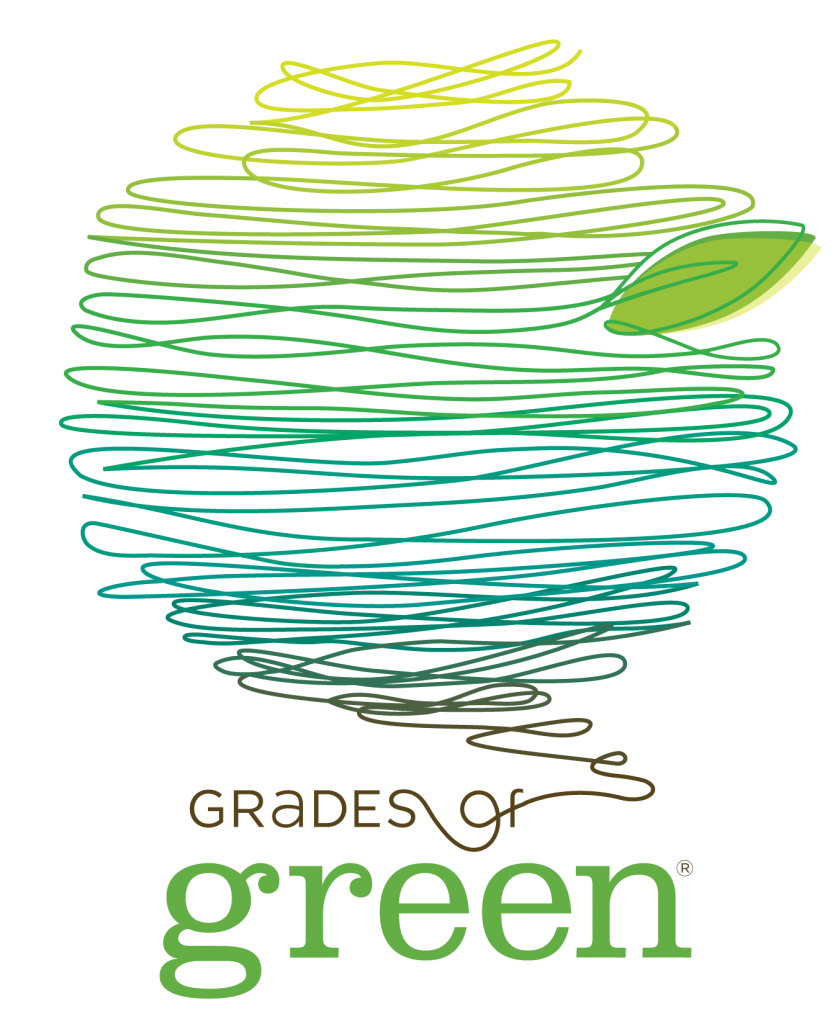Stop Packing Trash!
Reduce your school’s lunchtime waste by starting a Trash Free Lunch program. Students who bring food from home will reduce waste by packing food and drinks in reusable containers instead of single use plastics in addition to bringing reusable utensils and cloth napkins. Reducing lunchtime waste goes a long way in creating a more sustainable school campus. By using this Trash Free Lunches Toolkit along with the Lunchtime Sorting Toolkit, your school will be a leader in reducing the amount of waste sent to landfills.

Toolkit Details


NGSS
This toolkit address the following Science and Engineering Practices (SEPs) within the Performance Expectations of NGSS for Grades: 6-8 and 9-12
- Asking Questions and Defining a Problem
- Planning and Carrying out Investigations
- Analyzing and Interpreting Data
- Using Mathematics and Computational Thinking
- Constructing Explanations and Designing Solutions
- Obtaining Evaluating, and Communicating Information
Learning Objectives
- Analysis
- Students will analyze school lunches to determine whether or not they are Trash Free
- Project Management
- Students will identify routines
- Students will practice leadership skills by delegating tasks to each other
- Evaluation and Assessment
- Students will track and evaluate the impact of their project
Why It’s Important
Excess single-use packaging and waste from school lunches deplete natural resources and fill up our landfills contributing to the planet’s mounting plastic pollution crisis. The amount of waste produced by school time lunches is disproportionate from community to community. Underserved communities oftentimes have more single use packaging waste, resulting in more litter and trash going to landfills.
What You Will Accomplish
Trash Free Lunches reduce waste, save natural resources and cut down on greenhouse gas emissions that lead to climate change. Not only that, but by buying whole fruits, vegetables, and other foods in bulk–instead of prepackaged foods–families can save money and cut down on unhealthy, highly processed foods in their diet.
Why Should You Reduce Your Waste During Lunch?
The resources provided can be shown as a slideshow or printed out as individual worksheets for students to learn.

Lunches Create a Lot of Waste
According to the EPA, the average American student creates 67 pounds of lunch packaging waste each school year. That’s more than 18,000 pounds of plastic, paper, and other non-food materials for just one average-sized elementary school. Whether you’re packing a full lunch for school, bringing a snack, or packing food to go somewhere else, choosing to pack Trash Free reduces waste, saves natural resources, and saves money! [1]
Plastic is Hard to Recycle
In 2021, only 5-6% of plastic was recycled in the United States! Until recently, the US sent most plastic waste to other countries like China and Turkey to get recycled, but this is no longer an option.(https://www.ecowatch.com/recycling-stats.html#plastic) Most packaging is difficult to recycle because of the material(s) it is made with or it is contaminated with leftover food. Even when we put plastic in the recycle bin, most of it will still end up in a landfill. This plastic packaging is made from oil, a natural resource that requires energy to produce and release greenhouse gasses that cause climate change throughout its lifecycle. [2]
Choose to Go Trash-Free!
By making simple changes like packing food and drinks in reusable containers and bringing reusable utensils/cloth napkins/straws you can reduce your waste to make your school/community more sustainable.
Why Litter is an Environmental Justice Issue
Waste is often classified as an environmental justice issue due to the implications associated with where it is transported. Recycling facilities, waste transfer stations, incinerators, and landfills are all largely placed in developing regions internationally or in disenfranchised communities within the US. Any one or a combination of these facilities can cause widespread pollution in addition to health issues to communities that live nearby.
Watch these two short videos to learn why it’s important to reduce your waste!
Think About It!
Pre-Activity Questions
- What are the most common types of packaging you see in your lunch and the lunches of the students at your school?
- What are some swaps you can make in your own lunch to use less packaging and make less waste?
- What are some benefits of packing a Trash Free Lunch?
Take Action: How to LAUNCH Trash Free Lunch Program
Follow the steps below to set up a successful Trash Free Lunch Program at your school! Need help? Contact us!
Step 1: Who’s Participating?
- Determine who and how many students/staff are participating. Use the Trash Free Lunch Sign Up Sheet.
- Assign participants to educate peers, market the program throughout the school community and/or audit the results.
Step 2: Plan It Out
Determine the date that you want to kick off your Trash Free Lunch campaign and if you want to encourage students to go Trash Free one time, one day each week, or every day using the Trash Free Lunch Organizer.
Step 3: Audit Your School’s Lunches
- Schedule a day before your Trash Free Lunch campaign to audit school lunches to get a baseline of how many students are packing Trash Free.
- Print out the Trash Free Lunch Audit worksheet and head out to the lunch area with your team. Using tally marks, count the number of students at lunchtime who have brought a packed lunch to school. Out of those students, count how many students have completely Trash Free lunches, mostly Trash Free lunches and partially Trash Free lunches. A Trash Free Lunch is one in which all packed items can be eaten or reused (i.e. Lunch box, water bottle, snack and food containers, utensil, napkin) and there are no single-use items or packaging. Fruit and veggie scraps such as a banana peel or apple core should be counted as Trash Free!
- Record the data on the form and keep it somewhere you can access later to compare it to future audits that take place after your campaign.
If there are too many lunches to count, consider taking a large sample (about 100 students) and use what you’ve found to estimate the amounts for your whole school.
Step 4: Educate Your Classmates and School Staff
- Teach your peers how and why to pack a Trash Free Lunch. Deliver the results of your audit and the Trash Free Lunch Script at a school assembly, over announcements or by going class to class. Feel free to use the Trash Free Lunch Peer Presentation template.
- Spread the word about the program on campus by making posters and posting these flyers (How To Pack a Trash Free Lunch and Pack This Not That flyers) around school, on your school’s website or in an online school newsletter.
- It’s important to never make a student feel bad about bringing waste-causing packaging to school. Even one item in a reusable container should be celebrated! Reward all improvements with praise.
Step 5: Educate Families
Teach the parents at your school how and why to pack Trash Free for their students by sending home this flier in a school newsletter or posting it on the school’s website.
Step 6: Measure Your Impact
Using your Trash Free Lunch Audit worksheet, pick a date to audit your school’s lunches again.
- If you are choosing a “single day” goal for your campus to be Trash Free, conduct your post audit on that day.
- If you are choosing “one day a week” goal to be Trash Free, wait at least one week after your Campaign and conduct your audit on that day of the week.
- If you are choosing to go Trash Free every day, you can audit the school lunches weekly or monthly to see how it’s going.
Reflection Questions
How’d It Go?
- What changes did you see in student’s food packing habits after educating about Trash Free Lunches?
- What single use items do you still see the most of?
- What are some ways you can think of to reduce more waste during lunch?
Report Your Students’ Impact
Congratulations!! You’ve implemented Trash Free Lunch! Don’t let all that hard work go unnoticed. Submit your results by clicking the green button below.
Project ongoing? No problem! Let us know what you’ve done so far.
By reporting your impact, Grades of Green can:
- CELEBRATE and elevate your students’ hard work and success.
- Offer our programs FREE for all students across the globe.
- AWARD stipends and certificates to hard-working educators and students.
Please take a few minutes to submit your results. Thank you!
Provided Resources
- Trash Free Lunch Sign Up Sheet
- Trash Free Lunch Organizer
- Trash Free Lunch Audit Form
- Pack This Not That Flyer
- How To Pack a Trash Free Lunch
- Trash Free Lunch Student Presentation Script
- Trash Free Lunch Parent Education Flyer
- Trash Free Lunch Wrap Up Form
- Toolkit Resources – Google Drive Folder
Congrats on completing Trash Free Lunch Eco-Toolkit!
Did you enjoy this toolkit? Find your next project here!
